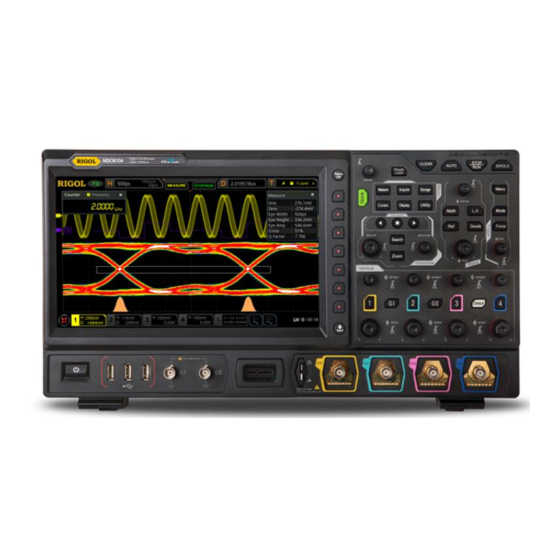
Rigol MSO8000 Manual
Hide thumbs
Also See for MSO8000:
- Quick manual (46 pages) ,
- Service manual (29 pages) ,
- Manual (405 pages)
Advertisement
Advanced
Embedded Debug
with Jitter and
Real-Time Eye
Analysis
Figure 1: The MSO8000 High Performance Oscilloscope
RIGOL – Innovation or nothing
Introduction
Debugging embedded communications is one of
the most common tasks for electronic design
engineers. Efficient Analysis of serial
communications requires more than simple
triggering and decoding but historically there
has been a significant cost difference between
the oscilloscopes with mixed signal, serial
triggering, and serial decode capabilities and the
high performance instruments with advanced
analysis. Engineers need the ability to test long
term signal quality characteristics including
jitter and eye patterns without investing in high
performance, high cost solutions.
The MSO8000 (Figure 1) provides the most
complete analysis capabilities, deepest memory,
and highest sample rate in its class. Built for
embedded design and debug, the MSO8000 is
designed to enable engineers to speed
verification and debug of serial communications
on a budget. Let's look at how class leading
sampling, memory, and analysis can be used
debug complex signal quickly and easily with the
help of Jitter and Eye Analysis.
Characterizing Jitter
Clock precision is critical to high
performance digital data transmission. Subtle
changes in clock frequency affect error rates and
data throughput, but these timing errors can't be
visualized easily in a traditional oscilloscope
view. Jitter analysis can be done on these types
of signals. Utilizing the high sample rate and the
deep memory, the oscilloscope compares the
changes in time between thousands of clock
transitions. This makes it possible to visualize
timing fluctuations below 100 picoseconds while
also tracking changes in clock timing over long
time periods.
Page | 1
Advertisement
Table of Contents

Summary of Contents for Rigol MSO8000
- Page 1 The MSO8000 (Figure 1) provides the most complete analysis capabilities, deepest memory, and highest sample rate in its class. Built for embedded design and debug, the MSO8000 is...
- Page 2 This is critical to understanding how to debug signal jitter. The TIE trend shows the period changes lengthening linearly (triangle rising) and then the period Figure 4: TIE trend and TIE Histogram RIGOL – Innovation or nothing Page | 2...
- Page 3 Figure 6: Standard Deviation of the histogram that can help to determine what signals might be interfering. Often, signal timing shows a sharper correction or snapback to the nominal timing as RIGOL – Innovation or nothing Page | 3...
- Page 4 PLL with 200 kHz of bandwidth it can eliminate much of the low frequency jitter we saw at 10 kHz. This is shown in Figure 8. The MSO8000 can emulate explicit, constant, 1 order PLL, and 2 order PLL clock recovery systems to precisely measure the jitter or eye diagram as it will be seen by the receiver.
- Page 5 500 picoseconds per division as shown in Figure 10. The MSO8000 Oscilloscope also enables a direct statistical table view of the TIE values as well as Cycle to Cycle values and values calculated from both the positive and negative widths.
- Page 6 Figure 13: Eye Diagram with improved noise RIGOL – Innovation or nothing Page | 6...
- Page 7 UltraVision II platform, RIGOL’s MSO8000 Series oscilloscopes are the high performance debugging tool of Figure 15: The MSO8000 High Performance Oscilloscope choice for today’s embedded engineer. RIGOL – Innovation or nothing Page | 7...
- Page 8 For more information on our oscilloscopes please go to rigolna.com or contact us directly at help@rigol.com or call us toll free at 877-4- RIGOL-1. RIGOL Technologies USA 8140 SW Nimbus Ave. Beaverton, OR 97008 877.474.4651 RIGOL – Innovation or nothing Page | 8...
















Need help?
Do you have a question about the MSO8000 and is the answer not in the manual?
Questions and answers